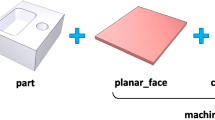Abstract
Recently, CNC machining simulations require exponentially increasing computational time and memories of the computers, which have become a significant challenge for both computer hardware and software. This paper presents a novel geometric model for CNC machining simulations, which is called Level of details based on G-Code, or G-LODs for short. The G-LODs uses a type of progressive mesh to construct the surface simulation grid (SSG). The SSG can be adopted to simulate the CNC machining processes at proper level of details. So theoretically simulations based on the G-LODs will not excessively occupy the computational and storage resources of computers. Based on the SSG, the G-buffer method is used to construct the solid model of the parts. The methodology of how to construct the G-LODs is established. In conclusion, several simulation examples based the G-LODs are presented.
Similar content being viewed by others
References
Jerard RB, Drysdale RL, Hauck KE, Schaudt B, Magewick J (1989) Methods for detecting errors in numerically controlled machining of sculptured surfaces. IEEE Comput Graph Appl 9:26–39
Chappel IT (1983) The use of vectors to simulate material removed by numerically controlled milling. Comput Aided Des 15(3):156–158
Oliver JH, Goodman ED (1990) Direct dimensional NC verification. Comput Aided Des 22(1):3–10
Oliver JH (1992) Efficient Intersection of surface normals with milling tool swept volumes for discrete three-axis NC verification. Trans ASME J Mech Des 114:283–287
Anderson RO (1978) Detecting and eliminating collisions in NC machining. Comput Aided Des 10(4):231–237
Fussell BK, Ersoy C, Jerard RB (1992) Computer generated CNC machining federates. Japan/USA Symposium on Flexible Automation ASME 1:377–384
Jerard RB, Drysdale RL, Hauck K, Schaudt B, Magewick J (1989) Methods for detecting errors in sculptured surface machining. IEEE Comput Graph Appl 9(1):26–39
Imani BM, Elbestawi MA (2001) Geometric simulation of ball-end milling operations. ASME J Manuf Sci Eng 123:177–184
Wang WP, Wang KK (1986) Geometric modeling for swept volume of moving solids. IEEE CG&A 6:8–17
Menon JP, Voelcker HB (1993) Toward a comprehensive formulation of NC verification as a mathematical and computational problem. J Des Manuf 3:263–277
Chiou C-J, Lee Y-S (1999) A shape-generating approach for multi-axis machining G-buffer models. Comput Aided Des 31:761–776
Saito T, Takahashi T (1991) NC machining with G-buffer method. Comput Graph 25(4):207–216
Menon JP, Robinson DM (1993) Advanced NC verification via massively parallel raycasting: Extensions to new phenomena and geometric domains. ASME Manuf Rev 6(2):141–154
Wang S-M, Chiou C-H, Cheng Y-M (2004) An improved dynamic cutting force model for end-milling process. J Mater Process Technol 148:317–327
Zhang Y, Luo Y, Wang JF, Li Z (2001) Research on the fractal of surface topography of grinding. Int J Mach Tools Manuf 41:2045–2049
Paris H, Peigne G, Mayer R (2004) Surface shape prediction in high speed milling. Int J Mach Tools Manuf 44:1567–1576
Spence AD, Li Z (2001) Parallel processing for 2-1/2 D machining simulation. Proc sixth ACM symposium on solid modeling and applications. Ann Arbor, MI, USA, pp 140–148
Hoppe H (1997) View-dependent refinement of progressive meshes. Comput Graph, SIGGRAPH ’97 Proc, pp 189–198
Hoppe H (1996) Progressive meshes. Comput Graph, SIGGRAPH ’96 Proc, pp 99–108
Erikson C, Manocha D(2000) Hierarchical levels of detail for fast display of large static and dynamic environments. UNC-CH Technical Report TR00–TR012
Kumar S, Manocha D, Lastra A (1996) Interactive display of large NURBS models. IEEE Trans Visualiz Comput Graph 2(4):323–336
Farin G (1993) Curves and surfaces for computer aided geometric design: a practical guide. Academic, San Diego
Lo C-C (2000) CNC machine tool surface interpolator for ball-end milling of free-form surfaces. Int J Mach Tools Manuf 40:307–326
Author information
Authors and Affiliations
Corresponding author
Rights and permissions
About this article
Cite this article
He, W., Bin, H. Simulation model for CNC machining of sculptured surface allowing different levels of detail. Int J Adv Manuf Technol 33, 1173–1179 (2007). https://doi.org/10.1007/s00170-006-0543-1
Received:
Accepted:
Published:
Issue Date:
DOI: https://doi.org/10.1007/s00170-006-0543-1




